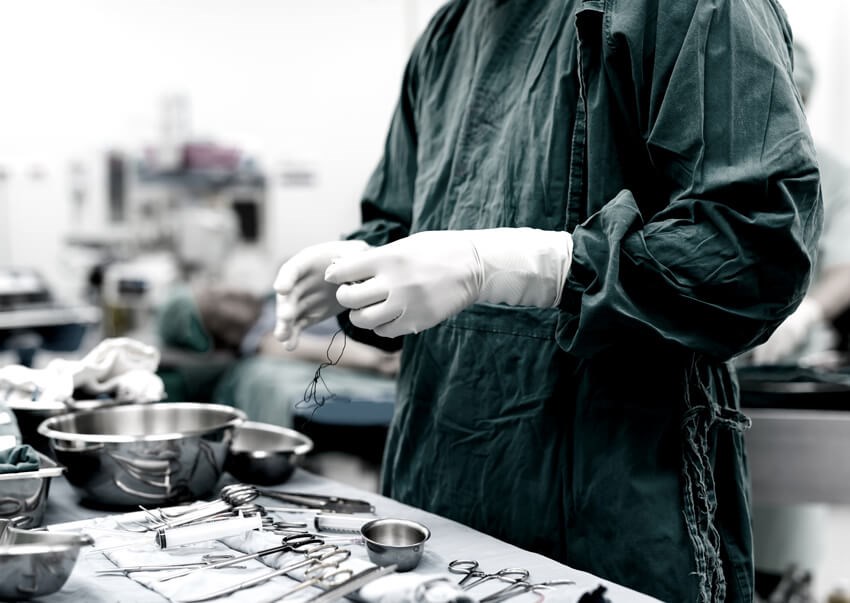
“…the quality of the studies was not good enough for the committee to make a strong recommendation for the choice of antiseptic preparation.”
NICE Guidelines NG125
Skin preparation before an invasive procedure is a part of all surgical procedures and for a long time was steeped in traditional practices. Shaving the surgical site and the traditional hand washing and scrub have now been critically examined and consigned to historical practice.
The evidence base for clinical practice is championed by the National Institute for Health and Care Excellence (NICE) and in this role it has proposed guidelines that cover preventing and treating surgical site infections in adults, young people and children who are having a surgical procedure involving a cut through the skin [1].

The issue of antiseptic skin preparation has recently caused some consternation as surgeons come under these guidelines that are applied by corporate bodies. Currently, the available options for skin antisepsis include:
- 0.5% chlorhexidine in 70% alcohol
- 2.0% chlorhexidine in 70% alcohol
- 4.0% aqueous chlorhexidine
- 10% povidone-iodine alcoholic solution
- 7.5% povidone -iodine aqueous solution
The NICE committee recommends that the agent of first choice should be 0.5% chlorhexidine in 70% alcohol, unless there is a contraindication for its use or when the surgical site is next to a mucous membrane. For surgical sites next to a mucous membrane, a 4% aqueous solution of chlorhexidine has been proposed as an alternative. The alcoholic iodine solution is reserved for cases where chlorhexidine is contraindicated and if both chlorhexidine and an alcoholic base are unsuitable then an aqueous solution is advised. These recommendations presuppose that the surgeon / surgical team are aware of the patient’s reaction to chlorhexidine; if there has been no previous exposure this may not have been documented. There is further recommendation that if diathermy is to be used, evaporation should be used to dry antiseptic skin preparations and pooling of the alcoholic solutions must be avoided. Furthermore, the guidelines also acknowledge the risks of using skin antiseptics in babies, in particular the risk of severe chemical injuries with the use of chlorhexidine (both alcohol-based and aqueous solutions) in preterm babies [2].
Given that problems with the recommended solutions have been identified, what evidence of excellence did the committee consider in coming to the recommendations? This information is available in a separate document which outlines the search strategies used to identify the effectiveness of skin antisepsis and an available Cochrane review which was used as an additional resource for the recommendations [3]. Initially 3808 studies were identified on a database, of these 110 were identified as potentially relevant with a further two additional studies identified through the Cochrane review. From a full text review of the 112 studies, 28 randomised controlled studies were considered; these used different interventions, different preparations and concentrations.
Overall, the evidence showed that chlorhexidine in alcohol was associated with the lowest incidence of surgical site infections (40.17 per 1000 operations [4.0%]), whereas aqueous povidone-iodine was associated with a higher incidence (59.58 per 1000 operations [6%]). Moreover, a pairwise analysis of alcohol concentration, iodine in alcohol preparation, aqueous chlorhexidine, aqueous povidone iodine, chlorhexidine in alcohol preparation, povidone iodine in alcohol preparation, adverse reactions (e.g., skin irritation, sepsis, skin reactions, hospital readmission rates, cellulitis, hospital length of stay) all revealed low-quality evidence and could not identify any difference in the analysis. Several studies did not have adequate power to capture infections, with a number of studies receiving grants from research councils and manufacturers. An economic analysis recalculated estimated savings of £29 per surgical case with chlorhexidine compared to povidone iodine, however this could be negated by other costs such as multiple applicators and disposal costs exceeding £30 per operation.
It was noted that chlorhexidine, which is a broad-spectrum antimicrobial, can cause generalised allergic reactions and anaphylactic shock. The prevalence of chlorhexidine hypersensitivity is rare; however, products containing chlorhexidine should not be applied on anyone with a possible history of an allergic reaction to chlorhexidine. Allergy to chlorhexidine appears to have a prevalence of 0.47-1% [4], although this is probably under-reported and can be a source of other side-effects [5].
Based on these analyses the committee proposed that an alcohol-based solution of chlorhexidine should be the first choice when selecting which antiseptic preparation to use. The quality of the studies was, however, not good enough for the committee to make a strong recommendation for the choice of antiseptic preparation.
The committee appears to acknowledge the risk of burns posed by alcohol-based preparations; however, it is not taken into account in terms of risks and potential litigation from such issues. Several legal claims have been reported, which clinicians should be aware of [6]. Incorrect identification of alcoholic chlorhexidine instead of aqueous chlorhexidine has contributed to surgical fires; this is mainly due to both solutions being pink in colour and being incorrectly selected. Incomplete evaporation and pooling, particularly under the drapes, will contribute to prolonged skin contact causing skin irritation, blistering and burns.
From a medico-legal aspect, it is recommended that all patients should be asked if they have any allergies to chlorhexidine; such aspects should be recorded, staff informed, and the appropriate alternative used. It is also recommended that patients are advised about the side-effects of chlorhexidine before use and that their acceptance to proceed is documented [6]. This in particular puts further onus on the surgeon to ensure further information giving and consent, without any responsibility being taken by the organisation which may be culpable for individual and systems errors in theatre.
Ultimately, the NICE report carries a disclaimer: “The recommendations in this guideline are not mandatory and the guideline does not override the responsibility of healthcare professionals to make decisions appropriate to the circumstances of the individual patient, in consultation with the patient and / or their carer or guardian.” This and the low-quality evidence and lack of a significant difference between the preparations may make it difficult to fully defend the mandatory use of the recommended products.
The NICE committee has also made further recommendations regarding further research; in relation to antiseptic skin preparation, the following has been proposed: “What is the clinical and cost effectiveness of a double application of antiseptic to the skin at the surgical site compared with a single application?” and “What is the clinical and cost effectiveness of different modes of applying skin antiseptic before incision in the prevention of surgical site infection?” In view of the recognised adverse effects of chlorhexidine and the lack of good quality studies to make a strong recommendation for the choice of antiseptic preparation, perhaps studies should be directed to identify new antiseptic products.
References
1. National Institute for Health and Care Excellence (NICE). Surgical site infections: prevention and treatment (NICE Guideline NG125). 2019.
https://www.nice.org.uk/guidance/ng125
[accessed 4 September 2023].
2. Medicines and Healthcare products Regulatory Agency (MHRA). Drug Safety Update Chlorhexidine solutions: reminder of the risk of chemical burns in premature infants. 2014.
https://www.gov.uk/drug-safety-update/
chlorhexidine-solutions-reminder-of-the-risk
-of-chemical-burns-in-premature-infants
[accessed 4 September 2023].
3. National Institute for Health and Care Excellence (NICE). Surgical site infection: prevention and treatment: [B] Evidence review for the effectiveness of skin antisepsis in the prevention of surgical site infection (NICE Guideline NG125).
https://www.nice.org.uk/guidance/ng125/
evidence/b-skin-antiseptics-in-the-prevention
-of-surgical-site-infection-pdf-6727104399
[accessed 4 September 2023].
4. Opstrup MS, Johansen J, Zachariae JD, Garvey LH. Contact allergy to chlorhexidine in a tertiary dermatology clinic in Denmark. Contact Dermatitis 2016;74(1):29-36.
5. Chiewchalermsri C, Sompornrattanphan M, Wongsa C, Thongngarm T. Chlorhexidine allergy: current challenges and future prospects. J Asthma Allergy 2020;9(13):127-33.
6. Haroon S. Coming clean about chlorhexidine. Case in Point - Medical Protection 2023;July:12-13.
COMMENTS ARE WELCOME






